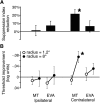Improved motion perception and impaired spatial suppression following disruption of cortical area MT/V5
- PMID: 21273412
- PMCID: PMC3078722
- DOI: 10.1523/JNEUROSCI.4121-10.2011
Improved motion perception and impaired spatial suppression following disruption of cortical area MT/V5
Abstract
As stimulus size increases, motion direction of high-contrast patterns becomes increasingly harder to perceive. This counterintuitive behavioral result, termed "spatial suppression," is hypothesized to reflect center-surround antagonism-a receptive field property ubiquitous in sensory systems. Prior research proposed that spatial suppression of motion signals is a direct correlate of center-surround antagonism within cortical area MT. Here, we investigated whether human MT/V5 is indeed causally involved in spatial suppression of motion signals. The key assumption is that a disruption of neural mechanisms that play a critical role in spatial suppression could allow these normally suppressed motion signals to reach perceptual awareness. Thus, our hypothesis was that a disruption of MT/V5 should weaken spatial suppression and, consequently, improve motion perception of large, moving patterns. To disrupt MT/V5, we used offline 1 Hz transcranial magnetic stimulation (TMS)-a method that temporarily attenuates normal functioning of the targeted cortex. Early visual areas were also targeted as a control site. The results supported our hypotheses and showed that disruption of MT/V5 improved motion discrimination of large, moving stimuli, presumably by weakening surround suppression strength. This effect was specific to MT/V5 stimulation and contralaterally presented stimuli. Evidently, the critical neural constraints limiting motion perception of large, high-contrast stimuli involve MT/V5. Additionally, our findings mimic spatial suppression deficits that are observed in several patient populations and implicate impaired MT/V5 processes as likely neural correlates for the reported perceptual abnormalities in the elderly, patients with schizophrenia and those with a history of depression.
Figures


Similar articles
-
Induced deficits in speed perception by transcranial magnetic stimulation of human cortical areas V5/MT+ and V3A.J Neurosci. 2008 Jul 2;28(27):6848-57. doi: 10.1523/JNEUROSCI.1287-08.2008. J Neurosci. 2008. PMID: 18596160 Free PMC article.
-
Inhibitory TMS over Visual Area V5/MT Disrupts Visual Speech Recognition.J Neurosci. 2023 Nov 8;43(45):7690-7699. doi: 10.1523/JNEUROSCI.0975-23.2023. Epub 2023 Oct 17. J Neurosci. 2023. PMID: 37848284 Free PMC article.
-
An enhanced role for right hV5/MT+ in the analysis of motion in the contra- and ipsi-lateral visual hemi-fields.Behav Brain Res. 2019 Oct 17;372:112060. doi: 10.1016/j.bbr.2019.112060. Epub 2019 Jun 25. Behav Brain Res. 2019. PMID: 31251957 Free PMC article.
-
Suppressive mechanisms in visual motion processing: From perception to intelligence.Vision Res. 2015 Oct;115(Pt A):58-70. doi: 10.1016/j.visres.2015.08.005. Epub 2015 Sep 2. Vision Res. 2015. PMID: 26299386 Free PMC article. Review.
-
Delineating extrastriate visual area MT(V5) using cortical myeloarchitecture.Neuroimage. 2014 Jun;93 Pt 2:231-6. doi: 10.1016/j.neuroimage.2013.03.034. Epub 2013 Mar 26. Neuroimage. 2014. PMID: 23541801 Review.
Cited by
-
Modulation of olfactory perception by visual cortex stimulation.J Neurosci. 2012 Feb 29;32(9):3095-100. doi: 10.1523/JNEUROSCI.6022-11.2012. J Neurosci. 2012. PMID: 22378882 Free PMC article.
-
Common and independent processing of visual motion perception and oculomotor response.J Vis. 2022 Mar 2;22(4):6. doi: 10.1167/jov.22.4.6. J Vis. 2022. PMID: 35293955 Free PMC article.
-
Gamma oscillations point to the role of primary visual cortex in atypical motion processing in autism.PLoS One. 2023 Feb 13;18(2):e0281531. doi: 10.1371/journal.pone.0281531. eCollection 2023. PLoS One. 2023. PMID: 36780507 Free PMC article.
-
Effects of Blue Light on Dynamic Vision.Front Psychol. 2019 Mar 19;10:497. doi: 10.3389/fpsyg.2019.00497. eCollection 2019. Front Psychol. 2019. PMID: 30941071 Free PMC article.
-
Modularity in the motion system: independent oculomotor and perceptual processing of brief moving stimuli.J Vis. 2014 Mar 24;14(3):28. doi: 10.1167/14.3.28. J Vis. 2014. PMID: 24665091 Free PMC article.
References
-
- Aaen-Stockdale CR, Thompson B, Huang PC, Hess RF. Low-level mechanisms may contribute to paradoxical motion percepts. J Vis. 2009;9:9.1–9.14. - PubMed
-
- Albright TD, Desimone R. Local precision of visuotopic organization in the middle temporal area (MT) of the macaque. Exp Brain Res. 1987;65:582–592. - PubMed
-
- Allen EA, Pasley BN, Duong T, Freeman RD. Transcranial magnetic stimulation elicits coupled neural and hemodynamic consequences. Science. 2007;317:1918–1921. - PubMed
-
- Antal A, Nitsche MA, Paulus W. Transcranial magnetic and direct current stimulation of the visual cortex. Suppl Clin Neurophysiol. 2003;56:291–304. - PubMed
Publication types
MeSH terms
Grants and funding
LinkOut - more resources
Full Text Sources
Molecular Biology Databases
Research Materials
Miscellaneous
